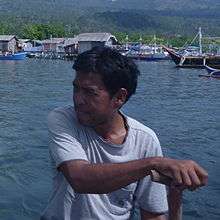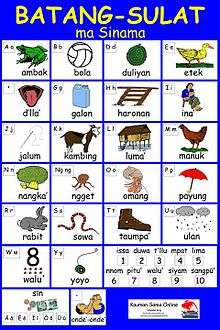Sama language
| Sama | |
|---|---|
| Bajau | |
| Sinama | |
| Native to | Philippines, Malaysia |
| Region | Tawi-Tawi and neighboring islands of the Sulu Archipelago (Sibutu, Siasi), Darvel Bay and north coast of Sabah |
| Ethnicity | Sama, Sama Banguingui |
Native speakers | 410,000 (2000–2007)[1] |
| Language codes | |
| ISO 639-3 |
Variously: ssb – Southern Sama sml – Central Sama sse – Balangingi Sama slm – Pangutaran Sama |
| Glottolog |
inne1244[2] |

The Sama language, Sinama (Sama + the infix -in-; also known as Siyamal and Bajau), is the language of Sama people of the Sulu Archipelago and the Bajau of Sabah, Malaysia. The Sama are one of the most widely dispersed peoples in Southeast Asia.
Classification
The Ethnologue divides Sinama into 4 languages based on mutual intelligibility. The 4 Sinama languages are Northern Sinama, Central Sinama, Southern Sinama, and Sinama Pangutaran from the island of Pangutaran off of Jolo island. Jama Mapun, a language from the island of Mapun, formerly known as Cagayan de Sulu, is a related language and sometimes also referred to as Sinama. These classifications are rarely recognized by Sama themselves who instead classify their Sinama by the village or island it originates from. The emic classification of a Sama person's language e.g. Silumpak, Laminusa, Tabawan generally form the different dialects of the 4 Sinama languages.
Dialects
| Northern Sinama | Central Sinama | Southern Sinama | Sinama Pangutaran |
|---|---|---|---|
| Tagtabun Balangingi' | Sama Kaulungan | Simunul | Pangutaran |
| Tonquil Balangingi' | Sama Dilaut | Sibutu' | Ubian (North) |
| Linungan | Musu' | Tandubas | |
| Panigayan Balangingi' | Laminusa | Sitangkai | |
| Landang-Gua' | Balimbing | Ubian (South) | |
| Sama Daongdong | Bannaran | Languyan | |
| Kawit Balangingi' | Bangaw-Bangaw | Sapa-Sapa | |
| Karundung | Tabawan | Bongao/Sanga-Sanga/Pahut | |
| Pilas | Manubal | ||
| Kabinga'an | Silumpak |
Phonology

Sinama languages have 21 to 24 phonemes. All Sinama languages have 17 consonants. Each language has from 4 to 7 vowels.
Consonants
The consonants of the Sinama languages are represented by the letters b, d, g, h, j, k, l, m, n, ng, p, r, s, t, w, y and '.
Representation of the glottal stop in Sinama has not yet reached a consensus among Sinama speakers. Linguists have suggested the use of an apostrophe like character (') for word final glottal stops. Central Sinama has adopted this for glottal stops in between vowels as well (i.e. a'a, the Sinama word for human). Other Sinama languages have chosen to follow Tagalog orthography and to leave this vowel medial glottal stop ambiguous. Sinama speakers often spell the word final glottal stop with an h at the end. Sinama speakers in Malaysia may also spell it with a k following the vowel softening patterns of Bahasa Melayu.
In certain dialects of Sinama b becomes β and g becomes Ɣ when found between two vowels.
Vowels
The vowels a, e, o, u are found in all Sinama languages and dialects. In addition to these 4 vowels i, ə, and ɔ are found in one or more Sinama language.
| a | e | i | o | u | ə | ɔ | |
|---|---|---|---|---|---|---|---|
| Northern[3] | a | e | o | u | |||
| Central[4] | a | e | i | o | u | ' | |
| Southern[5] | a | e | i | o | u | ||
| Pangutaran[6] | a | e | i | o | u | ' | ō |
| Jama Mapun[7] | a | e | i | o | u |
Many of the Sinama languages have contrastive vowel lengthening. This is represented by a macron over the vowel (āēīōū).
Stress
Sinama pronunciation is quite distinct from other nearby languages such as Tausug and Tagalog in that all of the Sinama languages primary stress occurs on the penultimate syllable of the word.[8]:124 Stress will remain on the penultimate syllable even with the addition of suffixes including enclitic pronouns. In Northern Sinama (Balanguingi') the stress will shift to the ultima when the penult is the mid central vowel /ə/.
Enclitic Pronouns
The 1st, 2nd, & 3rd singular pronouns -ku, -nu and -na respectively, the 1st plural inclusive pronouns -ta and -tam, as well as the 2nd plural pronoun -bi are all enclitics.[9] These enclitic pronouns change the pronunciation by shifting the stress of a word through the addition of a syllable; a verb or noun combined with a suffixed one syllable enclitic pronoun. Some Sinama orthographies represent this by writing both noun/verb and pronoun as one word e.g. luma'ta for "our house" in Central Sinama. Other orthographies represent this with a hypen e.g. luma'-ta for "our house" in Southern Sinama. Still others write this keeping the noun/verb separate from the prounoun e.g. luma' ta for "our house" in Northern Sinama.
Cultural References
The lyrics of the song called Kiriring Pakiriring (popularly known as Dayang Dayang) were written in the Simunul dialect of the Southern Sinama language.
Central Sinama and Southern Sinama are 2 of 6 languages used in the 2012 Filipino drama film, Thy Womb.
Sinama is featured on the 1991 edition of the Philippine one thousand peso bill. Langgal is written under a picture of a Sama place of worship. Langgal is the Sinama for that place of worship.
References
- ↑ Southern Sama at Ethnologue (18th ed., 2015)
Central Sama at Ethnologue (18th ed., 2015)
Balangingi Sama at Ethnologue (18th ed., 2015)
Pangutaran Sama at Ethnologue (18th ed., 2015) - ↑ Hammarström, Harald; Forkel, Robert; Haspelmath, Martin; Bank, Sebastian, eds. (2016). "Inner Sulu Sama". Glottolog 2.7. Jena: Max Planck Institute for the Science of Human History.
- ↑ http://www-01.sil.org/asia/philippines/mle/Bangingih_Orthography_Fact_Sheet.pdf
- ↑ "Description of the Sinama Alphabet (Central Sinama)". Kauman Sama Online: Sinama Social Network for Sama & Bajau. Retrieved 9 May 2015.
- ↑ http://www-01.sil.org/asia/philippines/works-ssb-guide.html
- ↑ http://www-01.sil.org/asia/philippines/mle/Sama_Pangutaran_Orthography_Fact_Sheet.pdf
- ↑ http://www-01.sil.org/asia/philippines/mle/Mapun_Orthography_Fact_Sheet.pdf
- ↑ Pallesen, Kemp. "Culture Contact and Language Convergence." SIL Philippines. Summer Institute of Linguistics, n.d. Web. 10 Nov. 2014. <http://www-01.sil.org/asia/philippines/ling/Culture_Contact_and_Language_Convergence_1985.pdf>.
- ↑ "Hurupan Sama Bahagiꞌ 1: Angay sinugpat saga pronoun ni kabtangan ma bihingna?". http://sinama.org. Kauman Sama Online. Retrieved 18 November 2014. External link in
|website=(help)